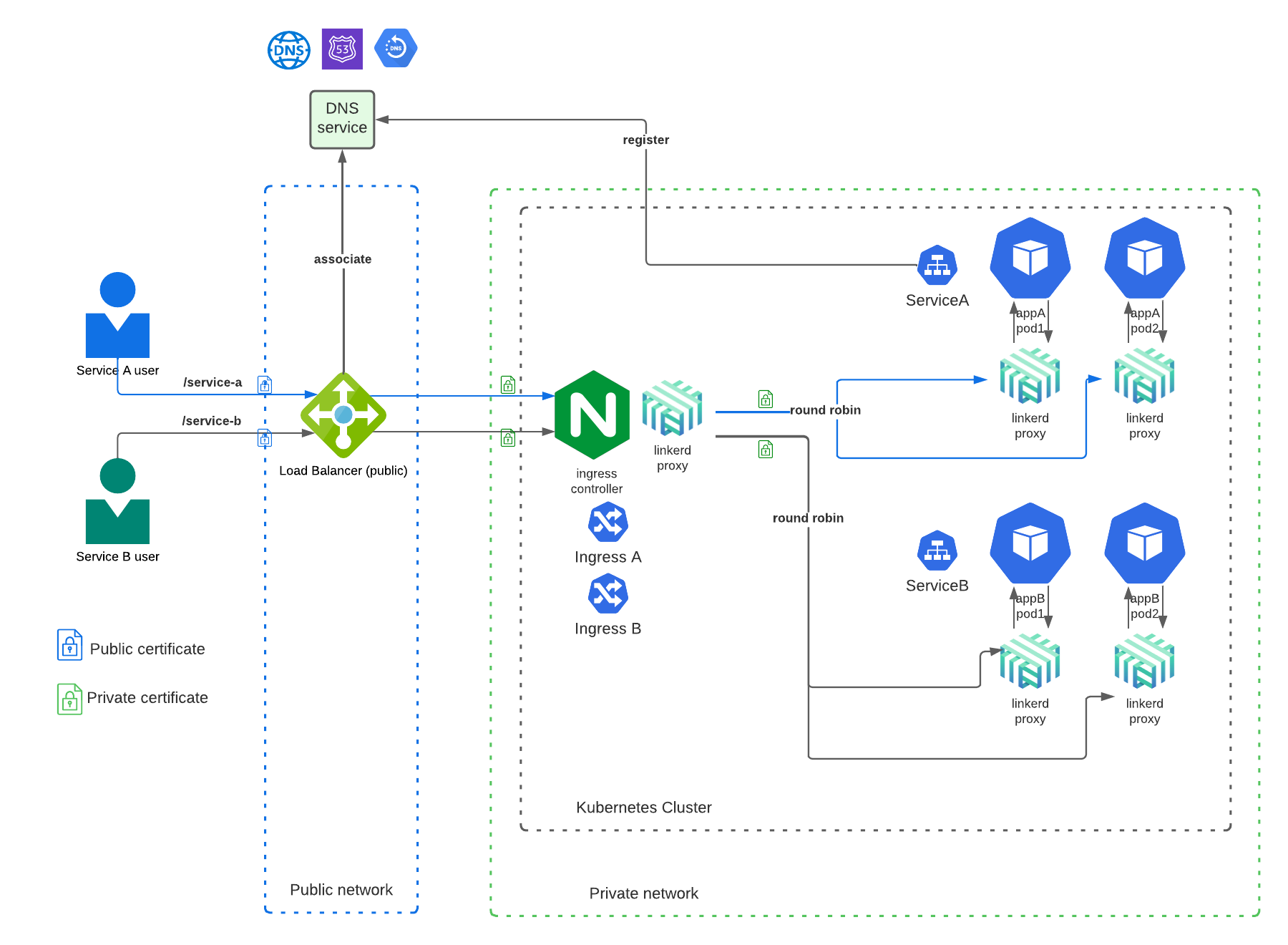Network Overview
Overview
Opta provides a pre-configured network architecture following best practices.
The main features are:
- Service mesh using Linkerd and Nginx for the ingress controller. This provides many networking features including Automatic mTLS and service discovery.
- Load Balancing.
- High availability to provide resiliency in case of zone outages
- Auto-scaling to only use what you need and to enable scalability.
- Public and private subnets to ensure isolation.
- Pre-configured firewall rules for increased security.
Kubernetes service networking
One of the main subjects Opta answers for its users is Kubernetes service networking – how services are exposed to the outside and talk to one another. Opta achieves this by utilizing a service mesh, kubernetes ingress, and kubernetes service discovery.

- Load Balancer (AWS Network LB, GCP External LB):
- distribute the traffic across multiple servers.
- do TLS termination for the public certificate - the certificate tied to the public DNS for the service.
- Ingress Controller (Nginx):
- distribute the traffic in the Kubernetes cluster.
- Linkerd control plane
- look up where to send requests.
- handle retries and timeouts.
- enable mutually-authenticated Transport Layer Security (mTLS) for all TCP traffic between meshed pods (see details).
- Linkerd proxy: ultralight transparent micro-proxy attached to every pod.
- handle all incoming and outgoing TCP traffic to/from that pod.
Service Mesh
All inter-service communication is handled by the Linkerd service mesh, which Opta installs by default.
Linkerd provides out-of-the-box mTLS, load balancing, retries and many other
reliability/security/qos features. Opta’s k8s-service modules are designed to
seamlessly assimilate into the installed service mesh. Combined with Linkerd’s official principles of
keep it simple, minimize resource requirements and just work, this means that
most development should not even notice the presence of Linkerd and upkeep should be nigh non-existent.
Service Discovery
Every service also gets an internal-only domain name that can be used by other
services to connect to it. The name is <service-name>.<layer-name>. Requests
sent to this domain will automatically get load balanced b/w all healthy
containers.
For example, the engine service in the diagram below, will be available at engine.back from any other service in the same environment.

name: back # layer name
environments:
- name: staging
path: "opta.yaml"
modules:
- type: k8s-service
name: back # k8 service name
port:
http: 80
image: ghcr.io/run-x/hello-opta/hello-opta:main
Lifecyle of a HTTPS request
This section presents the high level components by following the route of a HTTPS request for a API service. To illustrate the different types of network connections, this example has two services and two databases: one private and one public.

1 - A client sends a request such as https://startup.com/api/list-objects
- The DNS is publicly resolved to point to one of the public IPs of the load balancer.
- The load balancer serves the public TLS certificate for startup.com and as such is able to decrypt the HTTPS. The TLS termination is done at this level.
- The load balancer can scale its capacity to adjust to the load.
2 - The load balancer forwards the https request to an Nginx proxy in the Kubernetes cluster.
- The load balancer has multiple registered target of Nginx, typically one in each availability zone.
- Nginx listens on HTTPS port (443) using a self signed certificate.
- Opta supports 2 modes for nginx controller: default (1 pod) and high-availability (3 pods - one in each availability zone)
3 - The ingress controller forwards the request to a pod running the api container.
- The ingress controller uses the ingress rules to know which Kubernetes service should be matched with the url. Ex: /api/list-objects is for api-service. The ingress rule is set using the
public_urifield. - Linkerd enables mutually-authenticated Transport Layer Security (mTLS) for all TCP traffic between meshed pods.
- The number of pods for a given service is managed by an auto-scaler.
4 - The api-service pod sends a gRPC request to a data-service pod
- The service uses the internal service name for the hostname. The routing is done by Linkerd Control Plane service discovery feature.
- Linkerd can route gRPC and HTTPS, all using TLS.
- The number of pods for a given service is managed by an auto-scaler.
5 - The data-service pod sends a query to a privately hosted database
- The service uses the fully qualified name to connect to the DB.
- For outside connection, the service mesh proxy is not used.
- For AWS, TLS is always used with RDS. For GCP, TLS is not used by default.
- Cloud databases are organized in a cluster and can scale accordingly.
- This connection stays within the private subnets.
- The stored data is encrypted using the key using the KMS/Vault cloud service.
6 - The data-service pod sends a query to a public hosted database
- A Kubernetes pod is never exposed on the internet but can reach the internet through a NAT gateway.
- For outside connection, the service mesh proxy is not used.
- Multi-cloud databases such as MongoDB Atlas Atlas require TLS connection.
7 - The network address translation (NAT) gateway connects the public database
- Each NAT is attached to a fixed IP. We recommend to configure a firewall rule using this IP on the destination to restrict the incoming traffic.
From then, the api-service can return the HTTPS response with the api result.
Feedback
Was this page helpful?
Glad to hear it! Please tell us how we can improve.
Sorry to hear that. Please tell us how we can improve.